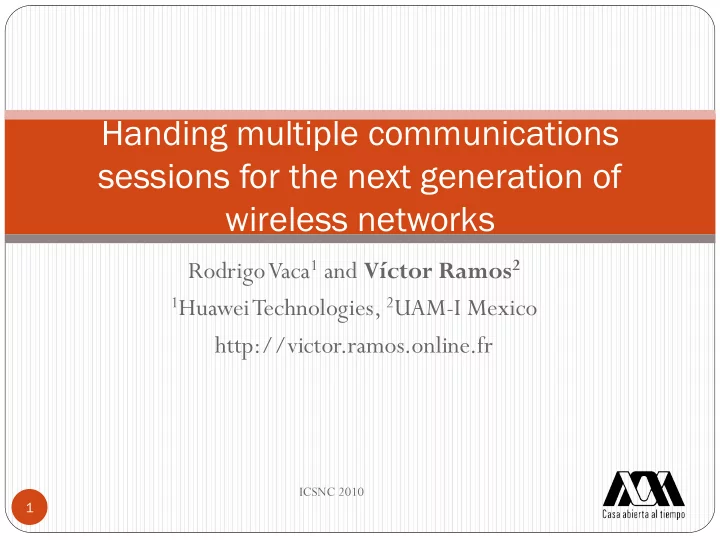

Handing multiple communications sessions for the next generation of wireless networks Rodrigo Vaca 1 and Víctor Ramos 2 1 Huawei Technologies, 2 UAM-I Mexico http://victor.ramos.online.fr ICSNC 2010 1
Outline Introduction Related work Handoff probabilistic algorithm Simulation results Conclusions and further work ICSNC 2010 2
Introduction ICSNC 2010 3
The handover process Mobile users experiment handoff events while moving within a wireless network. Handoff: maintain the active connections when a mobile node switches from an access network to another. Tha handoff management process is a very important issue in heterogenous scenarios. ICSNC 2010 4
Media Independent Handover IEEE 802.21 Media Independent Handover. Goals : Common structure for handoff. Seamless handover in homogeneous and heterogeneous environments. Three different services: Events (MIES) Commands (MICS) Information (MIIS) ICSNC 2010 5
802.21: Reference Model Coexistence among wireless networks. Coverage maps. Link parameters . ICSNC 2010 6
802.21: Architecture Communications sessions are kept while MIH interfaces exchange information . ICSNC 2010 7
Multiple Attribute Decision Making (MADM) Tool for evaluating competing alternatives with multiple attributes. Several MADM problems, same characteristics Multiple alternatives Multiple attributes qualitative/quantitative Attribute prioritization Matrix comparisons. ICSNC 2010 8
Classification of MADM methods ICSNC 2010 9
Rela elated ed wo work ICSNC 2010 10
AHP: Analytic Hierarchy Processes AHP: Allows to interpret quantitatively, quanlitative factors. AHP Build hierarchies Priority assignment Logic consistency AHP decomposes a decision problem into several problems. AHP structures an MADM problem by attributes ICSNC 2010 11
Handoff decision making Handoff decision making has been studied as a deterministic MADM problem. AHP is a decision making support which takes into account the different aspects of the decision making process. Drawback: AHP does not take into account the uncertainty of the judgements into the pairwise comparison matrix. ICSNC 2010 12
AHP hierarchy of our problem Goal : Handover to the network offering the best QoS for the mobile node applications. Criteria : Quantitative/qualitative parameters by which alternatives are judged. Alternatives : Possible options to choose ICSNC 2010 13
Our contribution Tawil, Pujolle and Demerjian[1], proposed a decision scheme to select the best suitable network. The problem is stated as an MADM problem. Yang et. al. [2], propose an MADM handover decision algorithm forWiMax and WiFi networks: The works in [1,2] assume that the handoff problem is a decision making process. Drawback: They see the problem as a deterministic issue. ICSNC 2010 14
Our contribution (2) We propose in [3] a novel method, similar to [2], but we model the handoff process as a probabilistic process. In this work , we present numerical comparisons between AHP and the classic RSS. [1] Distributed handoff decision scheme using MIH function for the 4th generation of wireless networks . ICTA 2008. [2] A vertical media handover decision algorithm acrossWi-Fi and WiMax networks. WOCN 2008 . [3] A vertical handoff algorithm which considers the uncertainty during the decision making process. WOCN 2009. ICSNC 2010 15
Handoff probabilistic algorithm ICSNC 2010 16
The proposed method Insert uncertainty into the pairwise comparison judgements. Each entry in the AHP matrix is a stochastic variable Use of a second kind Beta distribution to for comparison judgements Insert uncertainty. ICSNC 2010 17
Probability that each target network is the best I ( i h ) is the set of permutations of the h elements excluding the j -th one. ICSNC 2010 18
Performance comparisons Coverage area: UMTS and GPRS networks. Traffic classes 3GPP: conversational, streaming, interactive and background. Simultaneous sessions at the mobile node: Conversational and streaming Streaming and interactive Interactive and background Connection lifetime : exponentially distributed, varied between 1-5 minutes. ICSNC 2010 19
Results ICSNC 2010 20
Results ICSNC 2010 21
Conclusions QoS requirements must be considered in the handoff process. The proposed algorithm handoffs to the network with the best QoS when the mobile node carries multiple communications sessions. Our algorithm is sensitive to changes in the network conditions ICSNC 2010 22
Thanks! Merci ! ICSNC 2010 23
Recommend
More recommend